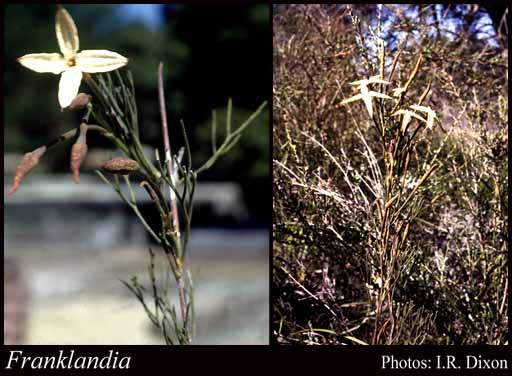- Reference
- Trans.Linn.Soc.London,Bot. p157 (1810)
- Name Status
- Current

Scientific Description
Common name. Lanoline Bushes. Family Proteaceae.
Habit and leaf form. Small shrubs; evergreen. To 1–1.6 m high. Mesophytic, or xerophytic. Leaves medium-sized to very large; alternate; usually spiral; leathery, or fleshy; petiolate; non-sheathing; bearing glandular cavities with internal hairs; edgewise to the stem, or with ‘normal’ orientation; simple; epulvinate. Leaf blades dissected; solid; terete; dichotomously dissected. Mature leaf blades adaxially glabrous; abaxially glabrous. Leaves without stipules; without a persistent basal meristem. Leaf anatomy. Hairs absent. Stem anatomy. Secondary thickening developing from a conventional cambial ring.
Reproductive type, pollination. Fertile flowers hermaphrodite. Unisexual flowers absent. Plants hermaphrodite. Entomophilous, or ornithophilous, or cheiropterophilous, or pollinated by unusual means.
Inflorescence and flower features. Flowers aggregated in ‘inflorescences’. Inflorescence few-flowered. Flowers not in pairs subtended by a common bract; in racemes. Inflorescences scapiflorous; terminal; elongate. The fruiting inflorescence not conelike. Flowers pedicellate; bracteate; medium-sized to large; regular; 4 merous; cyclic; tetracyclic. Floral receptacle developing a gynophore, or with neither androphore nor gynophore. Free hypanthium absent. Hypogynous disk present; extrastaminal; of separate members (comprising 4 glands, connate basally). Perianth of ‘tepals’; 4; 1 -whorled; joined (forming an elongated tube, the segments free towards the apex); glabrous; white to cream, or yellow (to gold), or red. Androecial members definite in number. Androecium 4. Androecial members adnate (to tepals); all equal; free of one another; 1 -whorled. Stamens 4; isomerous with the perianth. Anthers basifixed; non-versatile; dehiscing via longitudinal slits; introrse; four locular; tetrasporangiate. Pollen grains large, globose. Gynoecium 1 carpelled. The pistil 1 celled. Gynoecium monomerous; of one carpel; superior. Carpel stylate; apically stigmatic. Style straight. Carpel 1 ovuled. Placentation marginal, or apical. Ovary sessile. Styles becoming exserted. Stigmas capitate. Ovules funicled, or sessile; pendulous; non-arillate; orthotropous, or anatropous, or amphitropous, or hemianatropous.
Fruit and seed features. Fruit non-fleshy; hairy. The fruiting carpel indehiscent; nucular (nut narrow, surmounted by a horizontal plate or a long, trifid awn). Seeds non-endospermic. Embryo well differentiated. Cotyledons 2(–8). Embryo straight.
Special features. Stamens inserted within the floral tube.
Geography, cytology, number of species. Native of Australia. Endemic to Australia. Australian states and territories: Western Australia. South-West Botanical Province. N=14, 28.
Etymology. After Sir Thomas Frankland (1750–1831), English botanist who specialised in submarine plants.